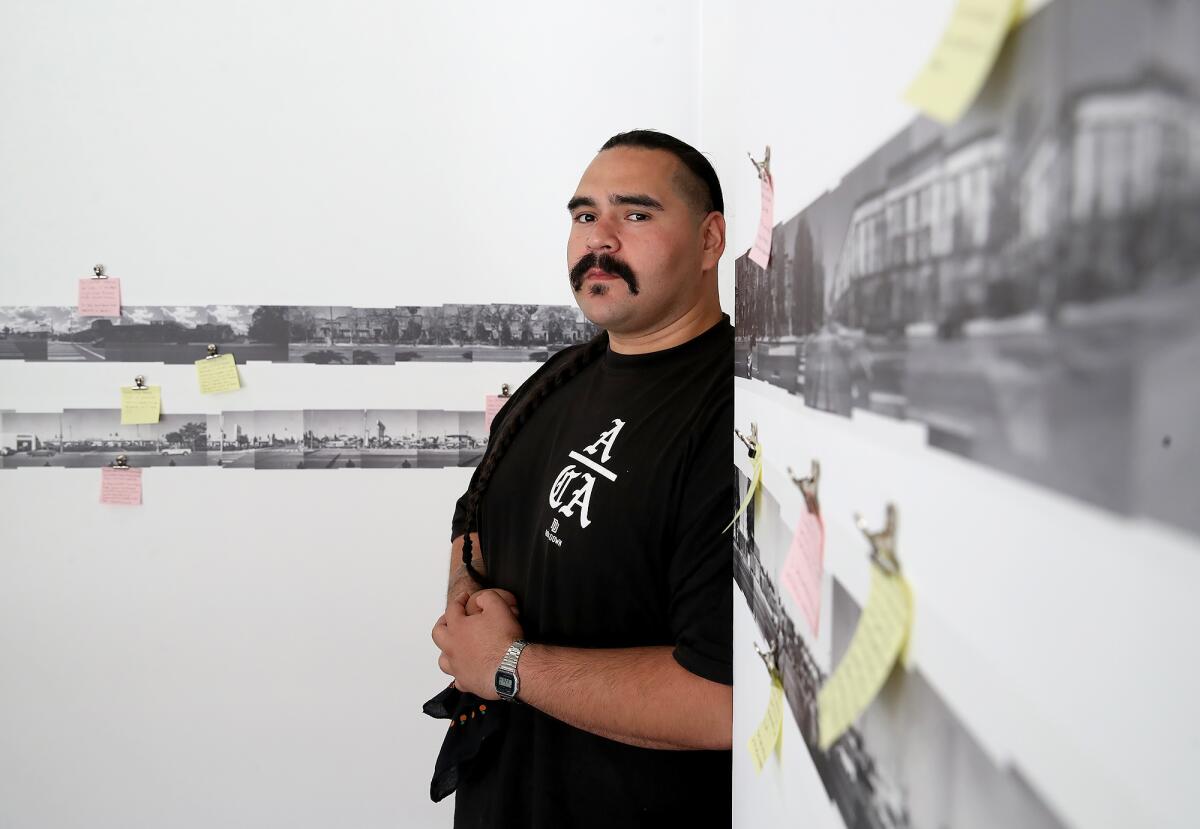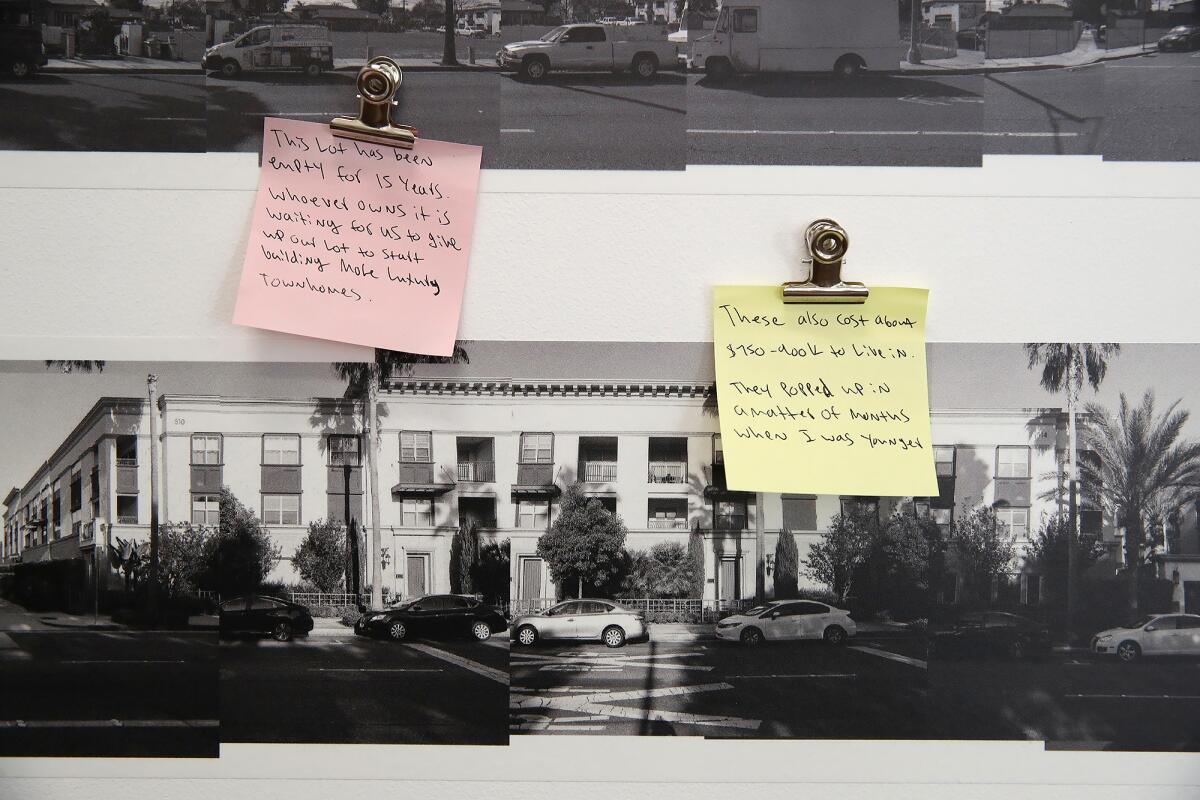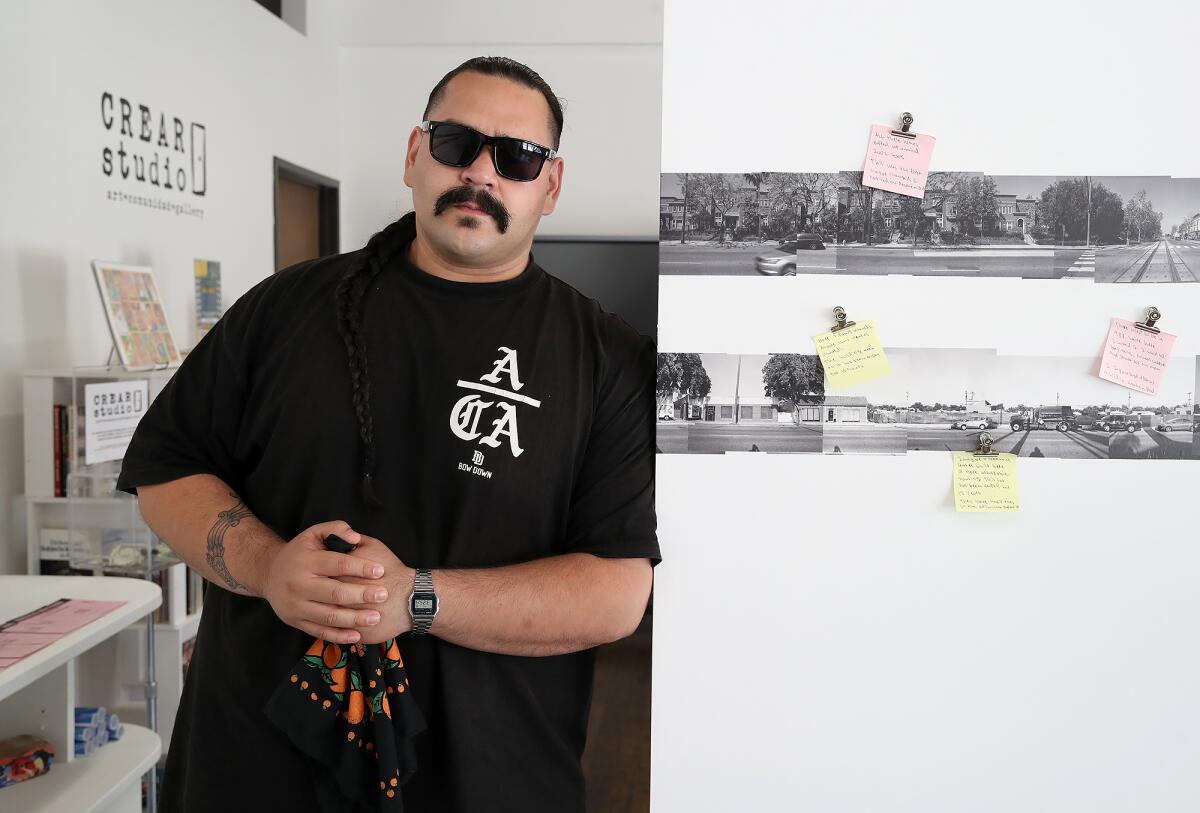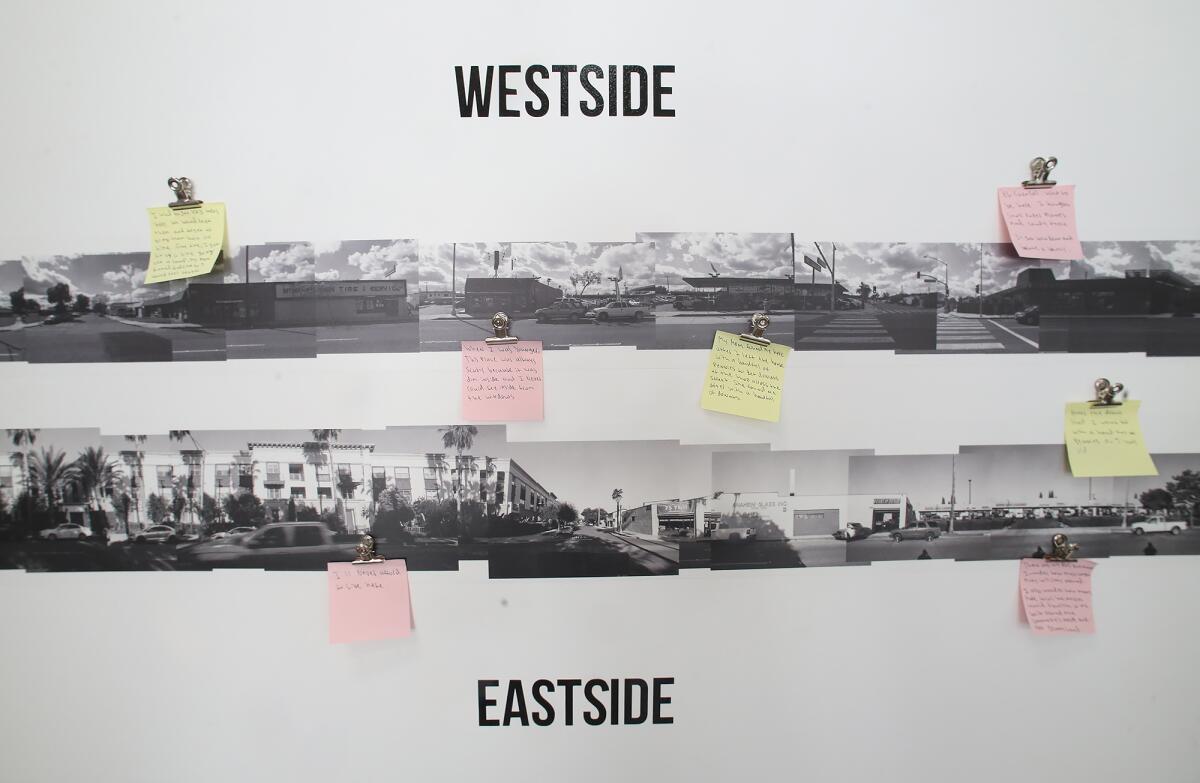Artist’s solo exhibition documents a changing Anaheim Boulevard

- Share via
There goes the neighborhood.
When Anaheim resident Alkaid Ramirez came home from college he returned to a neighborhood that hardly resembled the one he had left. Entire buildings and historic homes along Anaheim Boulevard were replaced by high-rises or, worse, empty lots.
“I was gone for a couple years and I came home and looked at the street I was very distraught,” said Ramirez. “It seemed like it was a whole different place when I returned.”
It was then that the artist and educator felt compelled to document the changing boulevard and the continuous redevelopment of Anaheim barrios in an attempt to save some part of the community that was once there, even if it was just its memory.
“Anaheim Blvd: Hood to Suburb” is the body of work that resulted from the four-year project. On view now at Crear Studio in Santa Ana, supported in part by LibroMobile Arts Cooperative, the solo exhibition uses traditional photography and poetry to craft a counter-narrative to the complex issue of gentrification and archive the swift changes.

Anaheim isn’t the only city in Orange County where communities have been displaced in the name of progress. Downtown Santa Ana business owners along 4th Street have struggled with the ongoing construction of a $509.5-million OC Streetcar car project since 2021. In Stanton’s Tina-Pacific neighborhood, fourplexes have been razed by the city, and empty units remain boarded up, the result of a years-long effort to redevelop the area.
“It really comes down to how close this hits to home,” said Ramirez. “This is me realizing that it’s knocking on my front door.”
In a piece called “Where Did the Neighbors Go?” an architectural light table displays a photo timeline of a luxury high-rise built in just nine short months on transparency paper. The light table stands on a patch of astro turf, signifying the artificial splendor of the quickly built housing. A suitcase sits at the center of the square of fake grass, a nod to the residents’ displacement from the neighborhoods they are priced out of.
Ramirez uses Post-it notes to ask questions about the construction pictured on the photo timeline, notes made in the margins of the plans. Realtor marketing advertisements are also on the table in their original format and as a doctored version Ramirez has created to reveal their true intentions.
For a section title “Return to Sender” Ramirez has “hijacked” postcards from commercial real estate firms sent to his family home asking to buy the property and uses their same tactics to respond.
“One of things that the developers do is work together with house flippers or hedge funders that come to your property or send you postcards saying, ‘Hey, we want to buy your house as is,’ and they flood your mailbox with postcards from all these different companies,” said Ramirez.
“ATTENTION Juan: I want to buy your property” reads a pink postcard from a Realtor. In identical fonts and colors, Ramirez has created his own postcard that reads “ATTENTION Monte: We are not going to sell you our home.”
Folks are invited to bring in similar postcards they have received or fill out the ones Ramirez has created to mail back to the companies.

“We will send them out en masse, so we will flood their mailbox like they flood ours,” said Ramirez.
From the planning phase, Ramirez moves the narrative into the leasing office and move-in marketing that is designed to draw people there. A-frames of posters declaring “Now Leasing” have been reimagined to read “Now Gentrifying” with the same festive balloons tied to the sign. Ramirez documents the replacing of the signs with three panels of photographs documenting the switch.
Ramirez has also tapped fellow Anaheim artist, Jesus Cortez, to participate in the exhibition. Two poems by Cortez, “What Will They Take?” and ”Down by Anaheim Blvd” printed on large blueprint-style maps of Anaheim, with a single black pushpin to notate the Ramirez family home.
“His work is amazing, but I always get choked up a little bit at the end of this poem, because it talks about the night in July 2012 when one of the Anaheim police officers gunned down an unarmed Manuel Diaz,” Ramirez said of “Down by Anaheim Blvd.”
The poem references a protest against police brutality the shooting inspired and the Anaheim police department shutting it down.
“After the fear, after the fury, an encounter with a gentrifier ended in them telling me to leave the area of Anaheim Blvd,” the last few lines of the poem read. “Only for me to remind them that I am more Anaheim than they they will ever be.”
The most impactful piece is a collage of photographs that fit together to show the full stretch of Ramirez’s childhood neighborhood off South Street and Anaheim Boulevard. Along the gallery’s longest wall, an uninterrupted view of the change happening is give full visibility.
“We have two 15-foot images of Anaheim Boulevard, viewing it from the west side and the east side of the lot. As you go down both sides of the street, you will notice there are Post-it notes that tell parts of my oral history, parts of the things that I remember and what used to be there,” said Ramirez.
Ramirez takes cues from Edward Ruscha’s photographs of Sunset Boulevard and Hollywood Boulevard for the piece, and the unbroken line tracing the length of the street brings it into focus in a way that can’t be observed by simply walking or driving it.
“As you go through the images, you start to see the changes in a grand scope. While you may be driving you can only see a building here and a building there; here you can see it all out in front of you.”

The photo will be included in a forthcoming book published by Seaton Street Press called “Anaheim Blvd: Hood to Suburb,” along with essays by Cortez and Crear Studio founder and author, Sarah Rafael García.
“It’s going be a 6 by 8 book that expands at 8 feet, so we will have this giant panoramic photo in the book,” said Ramirez.
And like the postcards, Ramirez encourages viewers to call a hotline he has set up to leave messages or stories of displacement for the redevelopers at (714) 729-3651.
Ramirez said he knows there are stories like his out there but different perspectives too. He said he would never want anyone who lives in these new developments to feel attacked. He said he hopes people come away from his work with a better understanding of just some of the ways gentrification is affecting Anaheim.
“My way of pushing these ideas is always being charitable to the individuals and being very harsh to the systems,” said Ramirez.
Ramirez said he would like to see the money these new developments bring to the local economy be used for community centers and education opportunities for youth. He knows the development of barrios like his isn’t stopping.
“I am hopeful for the future, but things continue to change, and we are still receiving postcards.”
“Anaheim Blvd: Hood to Suburb” is on view until Sept. 14, when an Artist Talk at 2 p.m. is planned. Crear Studio Gallery is located at 222 W. 5th St. in Santa Ana and is open from 4 to 8 p.m. Thursdays and Fridays and noon to 4 p.m. on Saturdays.
All the latest on Orange County from Orange County.
Get our free TimesOC newsletter.
You may occasionally receive promotional content from the Daily Pilot.




